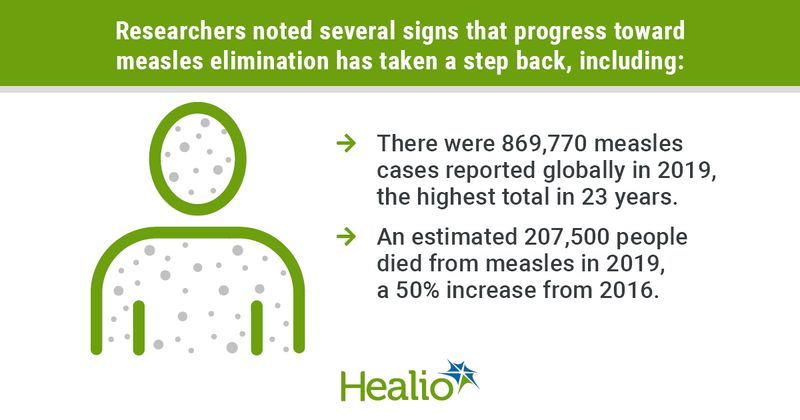Measles killed 207K people in 2019 as cases hit 23-year high
Globally, more than 207,000 people died from measles in 2019 as the number of cases of the highly contagious but preventable disease reached a 23-year high, researchers from WHO and the CDC reported.
Driven by gaps in vaccination and large outbreaks in several countries, cases increased in every region of the globe, indicating “a significant step backward in progress toward global measles elimination,” Minal K. Patel, MD, a medical epidemiologist in WHO’s Department of Immunization, Vaccines, and Biologicals, and colleagues wrote.

COVID-19 is complicating global efforts against measles by making it harder to vaccinate children and conduct proper surveillance, Patel and colleagues said.
“Progress toward measles elimination during and after the pandemic will require strategies to integrate catch-up vaccination policies into essential immunization services, assurance of safe provision of services, engagement with communities to regain trust and confidence in the health system, and rapid outbreak response,” they wrote.
According to the report, there were 869,770 cases of measles reported globally in 2019 — a 556% increase since 2016, when the world reported historic lows in both deaths and cases from measles. It was the highest total since 1996.
The estimated 207,500 deaths from measles in 2019 represented a nearly 50% increase from 2016 and an increase of close to 70,000 deaths over the 2018 total.
There were 120 cases per 1 million people, up from 18 cases per 1 million people in 2016. That is more than 24 times higher than a benchmark for global measles incidence set by the World Health Assembly (WHA) in 2010.
Another goal set by WHA in 2010 was for nations to achieve at least 90% coverage among children with the first dose of measles-containing vaccine. From 2000 to 2010, coverage increased from 72% to 84%, but it has since plateaued at around 84% to 85%, according to Patel and colleagues.
“In all WHO regions, the fundamental cause of the resurgence was a failure to vaccinate, both in recent and past years, causing immunity gaps in both younger and some older age groups,” Patel and colleagues wrote.
Nine countries accounted for 73% of all reported measles cases in 2019. Large outbreaks in the Democratic Republic of the Congo and Madagascar were “a consequence of accumulations of large numbers of measles-susceptible children, which resulted from longstanding extremely low” coverage with one dose of measles vaccine and no introduction of a second dose into national immunization programs, Patel and colleagues wrote.
An outbreak in the small Pacific island nation of Samoa was caused by a “steady decline” in measles vaccination “exacerbated by a decline in vaccine confidence after two infant deaths occurred from an error in measles-mumps-rubella vaccine administration,” they wrote. Other outbreaks, including one in the Ukraine that was caused by low vaccine confidence among heath care workers, also helped drive up the global total.
The United States came close to losing its measles elimination status last year because of two large travel-related outbreaks in New York that lasted almost a year. (Measles is considered re-established when one strain circulates in a country for 12 months or more.) Endemic measles transmission was re-established in Brazil and the United Kingdom.
The researcher estimated that measles vaccination has prevented 25.5 million deaths globally since 2000. Annual deaths from measles have declined 62% over that time, they reported.
A second study in MMWR reported that, globally, 13.8 million children did not receive the first dose of DTaP in 2019. The number of children who have not received the first DTaP dose has increased in Africa, the Americas and the Western Pacific, with overall coverage increasing little since 2010, according to the report.
References:
Chard AN, et al. MMWR Morbid Mortal Wkly Rep. 2020;doi:10.15585/mmwr.mm6945a7.
Patel MK, et al. MMWR Morbid Mortal Wkly Rep. 2020;doi:10.15585/mmwr.mm6945a1.

